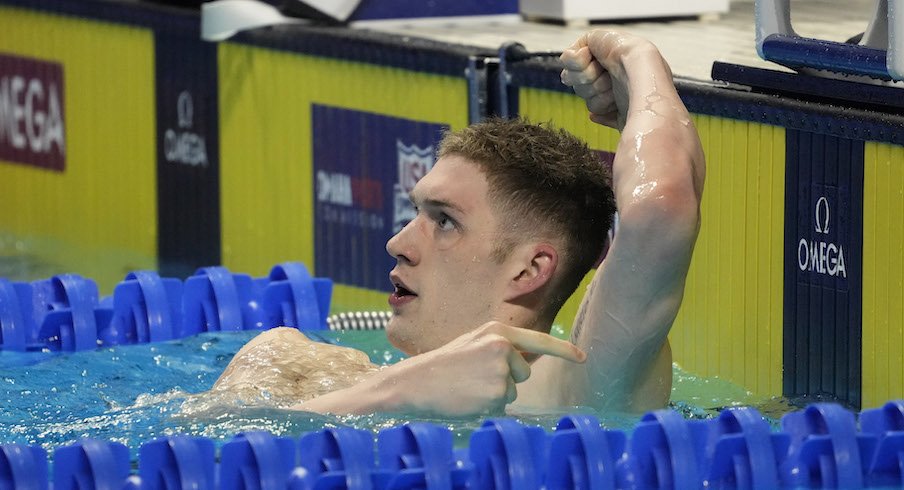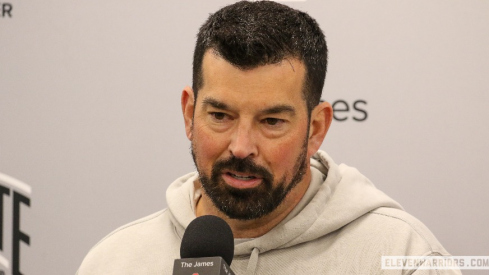They call him the Magic Man.
The roots of Hunter Armstrong’s moniker date all the way back to when, as an 8-year-old kid, he watched his friend Peyton Burris pull off what he now calls “the cheesiest card trick.” At the time, it rocked his world. Nowadays, he can’t believe he fell for it. But while riding to a swim meet at a YMCA, it was cool enough for him to want to give it a go himself.
“I told him I'm going to go home, I'm going to learn how you did that and I'm going to do it better than you,” Armstrong said last week. “And I came back the next day and I did it and I saw his reaction and I'm like, ‘There might be something to this.’ So I just kept going. I definitely think that magic has showed what it takes, just repetition, to get what you want.”
Nowadays it’s his No. 1 hobby outside of the pool. He’s big into card tricks but is trying to expand his magical horizons. Hence the rising junior Ohio State swimmer being called the Magic Man.
That name might as well also be used to describe his rise as a swimmer, though, because the way he and Ohio State associate head coach Matt Bowe describe his ascent, Armstrong needed a little magic along the way – not that many people who have seen him swim recently would guess that to be the case.
He stands today, at just 20 years of age and midway through his college years, as an Olympian set to compete at the Tokyo Games beginning next month.
Two weeks ago, Armstrong achieved what many people dream about, few even have a realistic chance of doing and an infinitesimal number of folks actually do. In the 100-meter backstroke finals of the U.S. Olympic Trials two weeks ago in Omaha, one of his outstretched fingers touched the wall to give him a personal-best time of 52.48 seconds. He placed second, behind only three-time Olympic Gold medalist Ryan Murphy, to secure a spot on the American team bound for Japan.
“My first instinct when you touch the wall is always to look at the scoreboard, especially at this meet, because first and second go,” Armstrong said. “So I actually looked at the place first and when I saw the place, I knew that I had gone fast enough. But I was definitely surprised to see the time along with it.”
#TokyoOlympics
— Ohio State Buckeyes (@OhioStAthletics) June 16, 2021
@OhioStSwimDive Hunter Armstrong rallies to take 2nd in 100m backstroke at #OlympicTrials #GoBuckeyes Toky-OH!
pic.twitter.com/pCyKOEFaT7
Right now, anybody who looks at the 6-foot-6 Buckeye can see his potential as a swimmer. Physically, with his lanky build, ample muscle and long arms, he’s designed to move rapidly through the water.
But a younger version of Armstrong never would have believed any of it – the time, swimming at the Olympic Trials, the fact he’s now an Olympian, even that he’s 6-foot-6 – to be possible.
As a child in the fewer-than-13,000-person Ohio town of Dover, just about all of his interest in swimming stemmed from his older brother, Jake, who turned into a two-time Big 12 champion at West Virginia. Armstrong credits him as “the whole reason” he started swimming in the first place. He wanted to be like him, he says. He also wanted to be better than him.
“We constantly compared how many medals and ribbons we got,” Armstrong said. “Even though mine were participation ribbons at the time, it still counted.”
Back then, he says, he wasn’t winning races. As he puts it, he was “the smallest one on the team” his entire childhood. He remembers losing to the girls his age.
“I mean, it was bad,” he said.
By middle school, second thoughts about the sport had entered his head. He thought about quitting entirely. He simply wasn’t having fun anymore. Everybody was growing except him.
Brenda Wherley, Dover High School’s swimming head coach, implored him to stick it out. As the one who got Armstrong started as a swimmer and taught him the sport, her voice held extra weight. Ultimately, he remained on the swim team as she urged him to just wait until high school.
That wasn’t a magical solution, though. Simply moving to ninth grade didn’t didn’t make every click.
Bowe remembers that he “wasn't very good” – at least in relation to other high schoolers Ohio State was looking at – until his senior year at Dover.
“I just remember seeing this kind of big, dangly kid with really long arms and legs,” Bowe said. “I remember looking at him in the water, thinking there's definitely some ability there if he gets strong and improves his technique.”
It wasn’t until a trip with his swimming club to Fort Lauderdale in 2018 – only three years ago – that Armstrong realized what might be possible if he dedicated himself to the sport. So, he went all-in.
From there, it’s been a sprint. An ascent faster than most would believe.
“I knew where I wanted to be and I wasn't going to let just being a late bloomer stop me from reaching my goals.”– Hunter Armstrong
Bowe remembers that Armstrong “really came through” in the summer after graduating from Dover and before he left for college. In August of 2019, Armstrong became a champion in the 50-meter freestyle, 100-meter freestyle and 100-meter backstroke at the Summer Junior Nationals, setting a meet record for the 100-meter backstroke.
By that time, the Buckeyes thought they had missed out on Armstrong. They had been one of two teams – along with West Virginia University – in the mix to have him swim for them at the collegiate level. The prior year, Armstrong had announced his decision to join his brother, Jake, as a Mountaineer. So in the fall of 2019, he began what he believed to be a four-year journey in West Virginia.
Ultimately, though, once his brother left Morgantown, he realized he wanted to go elsewhere. Thus, 14 months ago, he made the call to transfer to Ohio State following his freshman year.
“I followed him because I saw what West Virginia had done for him and it was a great opportunity,” Armstrong said. “I don't think a lot of people get to be at the same school as their older brother, and he was there to take care of me and walk me through my freshman year of college. But once he left, I realized that I wanted a little bit more from the sport and I knew who could get me there. Not to say West Virginia couldn't. But it was also a little bit nicer to be close to home.”
The past year-plus in Columbus helped Armstrong get stronger and more powerful in the first weightlifting program he has ever done with regularity. Bowe sees that as being “the biggest improvement for him this year.” Along the way, his coaches have also impressed the importance of being more detailed at his height.
So far, so good.
Armstrong placed second in the 100-meter backstroke, third in the 100-meter freestyle and fourth in the 50-meter freestyle near the end of his first season as a Buckeye. He then competed at the NCAA championships, taking 13th in the 100-meter backstroke and 21st in the 50-meter freestyle.
Good? Yes. Good enough for him to think he could be an Olympian? Not even close.
That bolt of confidence didn’t come until he showed up in Indianapolis at the TYR Pro Swim Series. In May, he surprised onlookers – even including his coaches, who knew he’d missed “a decent chunk” of training by going to a wedding in Virginia beforehand – by coming in first place in the 100-meter backstroke. He achieved a personal-best of 53.69 seconds.
“That was really the catalyst for me,” Bowe said. “I think then he started to believe, ‘OK, I’m now kind of in the mix where I could go to trials, make the final.’ I don’t think even he believed that the Olympic team was a possibility. But I think he just thought, ‘I could get in the final at Olympic Trials which would be fantastic.’”
Well, he did that and more.
Armstrong walked into the Olympic Trials and one-upped himself by going for a new personal record of 52.67 seconds in the semifinals of the 100-meter backstroke. Afterward, he remembers, he saw his brother cry for the first time ever.
The next day, on June 15, he did it again. Armstrong, despite coming out slower than he anticipated and turning at the midpoint of the race in seventh place, launched himself into a runner-up spot with a remarkable back half. Once more, he set a personal record, finishing in 52.48 seconds. His finish ensured he would become the first male Ohio State swimmer to make the U.S. Olympic team since 1956. As of the race – which took place a mere three years since he decided to push all his chips in on swimming – his time was good for sixth-best in the world.
“Hopefully I can drop a little more in Tokyo, but I could not be more happy with that time,” Armstrong said.
Another new best time? And for it to come next month in the Olympics?
For Armstrong, given his rapid rise, anything’s possible. Plus, it’s nothing a little bit of magic can’t help with.


